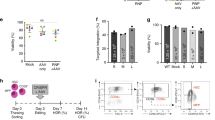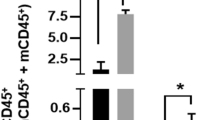Abstract
Erythropoietic protoporphyria is characterized clinically by skin photosensitivity and biochemically by a ferrochelatase deficiency resulting in an excessive accumulation of photoreactive protoporphyrin in erythrocytes, plasma and other organs. The availability of the Fechm1Pas/Fechm1Pas murine model allowed us to test a gene therapy protocol to correct the porphyric phenotype. Gene therapy was performed by ex vivo transfer of human ferrochelatase cDNA with a retroviral vector to deficient hematopoietic cells, followed by re-injection of the transduced cells with or without selection in the porphyric mouse. Genetically corrected cells were separated by FACS from deficient ones by the absence of fluorescence when illuminated under ultraviolet light. Five months after transplantation, the number of fluorescent erythrocytes decreased from 61% (EPP mice) to 19% for EPP mice engrafted with low fluorescent selected BM cells. Absence of skin photosensitivity was observed in mice with less than 20% of fluorescent RBC. A partial phenotypic correction was found for animals with 20 to 40% of fluorescent RBC. In conclusion, a partial correction of bone marrow cells is sufficient to reverse the porphyric phenotype and restore normal hematopoiesis. This selection system represents a rapid and efficient procedure and an excellent alternative to the use of potentially harmful gene markers in retroviral vectors.
This is a preview of subscription content, access via your institution
Access options
Subscribe to this journal
Receive 12 print issues and online access
$259.00 per year
only $21.58 per issue
Buy this article
- Purchase on Springer Link
- Instant access to full article PDF
Prices may be subject to local taxes which are calculated during checkout





Similar content being viewed by others
References
Kappas A, Sassa S, Galbraith RA, Nordmann Y . The porphyrias. In: Scriver CR, Beaudet AL, Sly WS, Valle D (eds) The Metabolic and Molecular Bases of Inherited Disease McGraw Hill: New York 1995 pp 2103–2160
Todd DJ . Erythropoietic protoporphyria Br J Dermatol 1994 131: 751–766
Baart de la Faille H et al. Erythropoietic protoporphyria: clinical aspect with emphasis on the skin Curr Probl Dermatol 1991 20: 123–135
Bloomer JR . The liver in protoporphyria Hepatology 1988 8: 402–407
Doss MO, Frank M . Hepatobiliary implications and complications in protoporphyria, a 20 year study Clin Biochem 1989 22: 223–229
Mercurio MG et al. Terminal hepatic failure in erythropoietic protoporphyria J Am Acad Dermatol 1993 29: 829–833
Ishibashi A et al. Erythropoietic protoporphyria with fatal liver failure J Gastroenterol 1999 34: 405–409
Lamoril J et al. Human erythropoietic protoporphyria: two point mutations in the ferrochelatase gene Biochem Biophys Res Commun 1991 181: 594–599
Sarkany RPE, Alexander GJMA, Cox TM . Recessive inheritance of erythropoietic protoporphyria with liver failure Lancet 1994 343: 1394–1396
Gouya L et al. Inheritance in erythropoietic protoporphyria: a common wild-type ferrochelatase allelic variant with low expression accounts for clinical manifestation Blood 1999 93: 2105–2110
Taketani S et al. Structure of the human ferrochelatase gene. Exon/intron gene organization and location of the gene to chromosome 18 Eur J Biochem 1992 205: 217–222
Wang X et al. Haplotype analysis of families with erythropoietic protoporphyria and novel mutations of the ferrochelatase gene J Invest Dermatol 1999 113: 87–92
Rüfenacht UB et al. Systematic analysis of molecular defects in the ferrochelatase gene from patients with erythropoietic protoporphyria Am J Hum Genet 1998 62: 1341–1352
Nordmann Y . Erythropoietic protoporphyria and hepatic complications J Hepatol Sep 1992 16: 4–6
Lichtin A et al. Correction of erythropoietic protoporphyria (EPP) phenotype by allogenic bone marrow transplant Blood 1998 92 (Suppl. 1): 532a (Abstr. 2146)
Tutois S et al. Erythropoietic protoporphyria in the house mouse. A recessive inherited ferrochelatase deficiency with anemia photosensitivity and liver disease J Clin Invest 1991 88: 1730–1736
Boulechfar S et al. Ferrochelatase structural mutant (Fechm1pas) in the house mouse Genomics 1993 16: 645–648
Pawliuk R et al. Long-term cure of the photosensitivity of murine erythropoietic protoporphyria by preselective gene therapy Nature Med 1999 7: 768–773
Fontanellas A et al. Reversion of hepatobiliary alterations by bone marrow transplantation in a murine model of erythropoietic protoporphyria Hepatology 2000 32: 73–81
Mathews-Roth MM . The treatment of erythropoietic protoporphyria Semin Liver Dis 1998 18: 425–426
Cavazzana-Calvo M et al. Gene therapy of human severe combined immunodeficiency (SCID)-X1 disease Science 2000 288: 669–672
Takenaka T et al. Enzymatic and functional correction along with long-term enzyme secretion from transduced bone marrow hematopoietic stem/progenitor and stromal cells derived from patients with Fabry disease Exp Hematol 1999 27: 1149–1159
Nolta A, Kohn D . Haematopoietic stem cells for gene therapy. In: Potten CS (ed.) Stem Cells Academic Press: London 1997 pp 447–462
Mazurier F et al. Rapid analysis and efficient selection of human transduced primitive hematopoietic cells using the humanized S65T green fluorescent protein Gene Therapy 1998 5: 556–562
Fontanellas A et al. Fluorescence-based selection of retrovirally transduced cells in congenital erythropoietic porphyria: direct selection based on the expression of the therapeutic gene J Gene Med 1999 1: 322–330
Fontanellas A et al. Correction of uroporphyrinogen decarboxylase deficiency (hepatoerythropoietic porphyria) in Epstein–Barr virus-transformed B-cell lines by retrovirus-mediated gene transfer: fluorescence-based selection of transduced cells Blood 1999 94: 465–474
Steinbach P et al. Cellular fluorescence of the endogenous photosensitizer protoporphyrin IX following exposure to delta-aminolevulinic acid Photochem Photobiol 1995 62: 887–895
de Goeij AFPM, Christianse K, van Steveninck J . Decreased haem synthetase activity in blood cells of patients with erythropoietic protoporphyria Eur J Clin Invest 1975 5: 397–400
Koningsberger JC et al. Exogenous protoporphyrin inhibits Hep G2 cell proliferation increases the intracellular hydrogen peroxide concentration and causes ultrastructural alterations J Hepatol 1995 22: 57–65
Bloomer JR, Hill HD, Kools AM, Straka JG . Heme synthesis in protoporphyria Curr Probl Dermatol 1991 20: 135–147
Miller AD, Rosman GJ . Improved retroviral vectors for gene transfer and expression Biotechniques 1989 7: 980–982
Landau NR, Littman DR . Packaging system for rapid production of murine leukemia virus vectors with a variable tropism J Virol 1992 66: 5110–5113
Varas F, Bernad A, Almendral JM, Bueren JA . Relevance of myeloablative conditioning in the engraftment of limiting numbers of normal and genetically marked lympho-hematopoietic stem cells Bone Marrow Transplant 1996 18: 981–989
Camadro JM, Labbe P . A simple ferrochelatase assay Biochimie 1981 63: 463–465
Grandchamp B et al. Studies of porphyrin synthesis in fibroblasts of patients with congenital erythropoietic porphyria and one patient with homozygous coproporphyria Biochim Biophys Acta 1980 629: 577–586
Gabe M . Techniques Histologiques Masson & Co: Paris 1968
Acknowledgements
We are grateful to M Landry for liver histological analysis, to F Belloc for flow cytometry analysis, to I Lamrissi-Garcia, S Landriau and M Sanchez for technical assistance and to JY Daniel and P Costet for the animal facilities. This work was supported by the Institut National de la Santé et de la Recherche Médicale (INSERM No. 9508), by Association Française contre les Myopathies (AFM), by the Spanish Fondo de Investigaciones Sanitarias (FIS No. 00/0446) and Comunidad Autónoma de Madrid (CAM No. 08.6/0003/1999.1). The animal facility was financed by a grant from the Comité Départemental des Pyrénées Atlantiques de Ligue Nationale contre le Cancer, and from Région Aquitaine. A Fontanellas was supported by the Spanish Instituto de Salud Carlos III (ISCIII No. 98/3165).
Author information
Authors and Affiliations
Rights and permissions
About this article
Cite this article
Fontanellas, A., Mendez, M., Mazurier, F. et al. Successful therapeutic effect in a mouse model of erythropoietic protoporphyria by partial genetic correction and fluorescence-based selection of hematopoietic cells. Gene Ther 8, 618–626 (2001). https://doi.org/10.1038/sj.gt.3301427
Received:
Accepted:
Published:
Issue Date:
DOI: https://doi.org/10.1038/sj.gt.3301427
Keywords
This article is cited by
-
Skin Ferrochelatase and Photosensitivity in Mice and Man
Journal of Investigative Dermatology (2010)
-
Successful match-unrelated donor bone marrow transplantation for congenital erythropoietic porphyria (Günther disease)
European Journal of Pediatrics (2005)
-
Hematopoietic stem cell gene therapy of murine protoporphyria by methylguanine-DNA-methyltransferase-mediated in vivo drug selection
Gene Therapy (2004)



